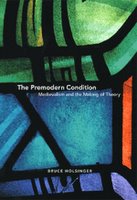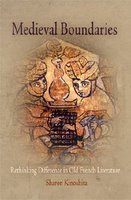
Won't be posting for a while.

"Few academic journals can pull off two articles about farting in one issue, butExemplaria does it with panache."
Is he dreaming of another world containing kingdoms without number?
-- William of Newburgh, History of English Affairs, 1.Prologue
It is the inhuman, the beyond the human, the less than human, the border that secures the human in its ostensible reality ... We must learn to live and to embrace the destruction and rearticulation of the human in the name of a more capacious and, finally, less violent world, not knowing in advance what precise form our humanness does and will take.
-- Judith Butler, Undoing Gender 218, 35


In East Anglia there is a village which is said to lie four or five miles from the famous monastery of the blessed king and martyr Edmund. Close to the village some very ancient ditches are visible. In English they are called Wlfpittes or wolf-ditches, and they lend their name to the village close by [modern Woolpit, in Sussex, a village that now uses this story to attract tourists]. At harvest-time, when the harvesters were busy in the fields gathering the crops, two children, a boy and a girl, emerged from these ditches. Their entire bodies were green, and they were wearing clothes of unusual colour and unknown material. As they wandered bemused over the countryside, they were seized by the reapers and led to the village. Many people flocked to observe this most unusual sight, and for several days they were kept without food. So they were now almost fainting with hunger, yet they paid no attention to any food offered to them. It then chanced that beans were brought in from the fields; they at once grabbed these, and looked for the beans in the stalks, but when they found nothing in the hollow of the stalks they wept bitterly. Then one of the bystanders pulled the beans from the pods and offered them to the children, who at once gleefully took and ate them.
For several months they were nourished by this food until they learned to eat bread. In the end they gradually lost their own colour when the qualities of our foodstuffs had their effect. They became like us, and also learned the use of our speech. Persons of prudence decided that they should receive the sacrament of holy baptism, and this was also administered. But the boy, who seemed to be younger, lived only a short time after baptism and then died prematurely, whereas the girl continued unaffected, differing not even in the slightest way from the women of our kind. She certainly took a husband later at Lynn, according to the story, and was said to be living a few years ago.
Once they had the use of our language, they were asked who they were and where they came from. They are said to have replied: 'We are people from Saint Martin's land; he is accorded special reverence in the country of our birth.' When they were next asked where that land was, and how they had come from there to Woolpit, they said: "We do not know either of these things. All we remember is that one day we were pasturing our father's flocks in the fields, when we heard a mighty din such as we often hear at St. Edmund's when they say the bells are ringing out. When we turned our attention to the sound which caused us surprise, it was as though we were out of our minds, for we suddenly found ourselves among you in the fields where you were harvesting." When they were asked whether people believed in Christ there, or whether the sun rose, they said that it was a Christian country and had churches. "But the sun does not rise among the natives of our land," they said "and it obtains very little light from the sun's rays, but is satisfied with the measure of its brightness which in your country precedes its rising or follows its setting. Moreover a shining land is visible not far from our own, but a very broad river divides the two." They are said to have made these and many other replies too long to narrate to interested enquirers. (1.27)



LONDON (AFP) - The discovery of a Turkish family that walks on all fours could aid research into the evolution of humans.
Researchers believe the five brothers and sisters, who can walk naturally only on all fours, may provide new information on how humans evolved from four-legged hominids to walk upright.
Nicholas Humphrey, evolutionary psychologist at the London School of Economics, told The Times the discovery opened "an extraordinary window on our past".
"I do not think they were designed to be quadrupeds by their genes, but their unique genetic make-up allowed them to be," he said.
"It has produced an extraordinary window on our past. It is physically possible, which noone would have guessed from the [modern] human skeleton."
The siblings, the subject of a new BBC documentary to be aired on March 17, suffer from a genetic abnormality that may prevent them from walking upright.
Instead, they use their palms like heels with their fingers sticking up from the ground.
The BBC said the documentary would contribute to fierce scientific debate and raised profound questions about what it is to be human.
Humphrey, who has contributed to the documentary, believes the style of walking may be a throwback to a form of behaviour abandoned by humans more than three million years ago.
Two sisters and one son have only ever walked on two hands and two feet, while another daughter and son occasionally walk on two feet.
All five are mentally retarded and have problems with language as a result of a form of underdevelopment of the brain known as cerebellar ataxia.
However Humphrey told the Times their behaviour may be partly the result of their parents tolerating the behaviour in childhood.
They are aged between 18 and 34 and live in southern Turkey, athough the makers of the documentary have not disclosed their exact location.
"They walk like animals and that's very disturbing at first. But we were also very moved by this family's tremendous warmth and humanity," Jemima Harrison of Passionate Productions told the Times.
Because the very basic idea that history lives, that even distant and relatively unexplored times and places are relevant to twentieth-century American lives, suggests sites of cultural relation that are unpredictable, uncontrollable ... we can forge dynamic relations to the past, even the distant or unfamiliar past, even if at present we do not know where such relations will lead ... using ideas of the past, creating relations with the past, touching in this way the past in our efforts to build selves and communities now and into the future. (Carolyn Dinshaw, Getting Medieval: Sexualities and Communities, Pre- and Postmodern 177, 206)

Elephant theory in Nessie search
Unexplained Nessie sightings could have been elephants swimming
Unexplained sightings of the Loch Ness monster could have been elephants enjoying a swim, a scientist has said.
Neil Clark, curator of palaeontology at Glasgow University's Hunterian Museum, spent two years researching Nessie.
He said they could have been circus elephants, as fairs visiting Inverness would often stop on the banks of Loch Ness to give the animals a rest.
When the saint stayed for some days in Pictland, he had to cross the River Ness. Reaching its banks, he saw spome locals burying a corpse. They told Columba a water beast had snatched and savagely mauled him while he was swimming ... Columba astonished these men by ordering one of his companions to swim across the river and sail back in the little boat on the other shore. The companion obeyed immediately, took off his clothes and dived into the water. The beast was deep beneath, still hungry for prey. It sensed the swimmer's disturbance of the waters and swam quickly towards the surface, mouth open and roaring furiously. The man was only in midstream. All the bystanders froze in terror, but Columba raised a hand, made the sign of the cross, and commanded: 'Desist. Do not touch the man. Go back immediately.' At the sound of the holy voice the beast swam away in terror, as quickly as if ropes had pulled it away.
-- Adomnan of Iona, Life of St Columba 2.27



A recent ‘discovery’ on what appears to be French (Belgian?) TV made the rounds on a couple of mailing lists I was on recently—the claim was the researhcers were using new archaeological techniques to recover sound from pottery that is hundreds of years old. The idea is that you can, for instance, recover the sounds of people saying things like “damn—why did it get so dark all of a sudden” in Latin off of vases that were dug up in Pompeii.
Not surprisingly, this turned out to be a hoax. It turns out that this idea has quite a history. The idea was first reported in the article Ancient Recordings from Antiquity which appeared in the Proceedings of the IEEE in 1969. From there it appeared in Gregory Benford’s 1979 short story Time Shards, which itself spawned episodes of X-Files and CSI.
I don’t think anyone took this recurring hoax very seriously, but you know how it is—anything with a long enough Google Trail is going to convince someone that there must be something to the story. Also I sort of like the weird alignment of people who seemed most interested in this story—cultural studies types to whom this seemed technically feasible, the Boing-Boing/Make crowd who think it ought to be true even if it isn’t, and of course the fundamentalist Christians.
Beethoven's late works, according to Solomon, exude a new sense of private striving and instability that is quite different from earlier works such as the "Eroica" Symphony and the five piano concertos that address the world with self-confident gregariousness. The masterpieces of Beethoven's final decade are late to the extent that they are beyond their own time, ahead of it in terms of daring and startling newness, later than it in that they describe a return or homecoming to realms forgotten or left behind by the relentless forward march of history.